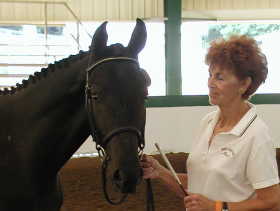I think some of the BIG look is lines. From behind the dashboard, all the lines are swept back and upward. Front wheel to fenders, rising angle. Laprobe and driver, front line is angled to seatback, rising, light against dark paint. Groom white knees against the rising fender end, groom slightly angled back, just makes it all look tall.
Wedge seat of driver, GOOD posture, make driver and groom appear quite tall.
Physically, the pony in slower work, especially from the front, going into the one-handed circle, is within the parameters of good fit. His rump is about even with top of dash, almost covers it, in that front-on photo.
Vehicle appears light and airy, not imposing with the delicate look of refined animal.
Extended gait photos, the pony drops his back level a LOT. He does look too small in those shots, because his rump and back are so far below the dash height. Great extensions! But any animal that drops so far below dashboard when extended, may look too small for their vehicle, in those short periods of time.
Again, I think the visuals of turnout lines, may enhance the larger look to carriage and passengers. Contrast of pony, clothing of driver, dark vehicle, may make the lines sharper in color changes to add to the visuals. I don’t see anything actually wrong in sizing. Very hard to fit smaller animals, driver with height or long legs. You do want driver legs more straight, not bent knees like chair sitting.
We prefer 4-wheels to drive with. We learned the 2-wheel lesson when we changed to the bigger horses. You CANNOT turn as short with large horse in 2-wheelers, as you can with 4-wheels. Lucky she was tall, or we could not have eased the shafts ABOVE the fence that did not permit her to fit in the hazard. She sort of half-passed, sliding shafts past and along fence top to make the turn. Measuring later, she PHYSICALLY should NOT have been able to get thru there. Cart alone, was too big to fit.
We walked the hazards, using almost max time to ease thru. Some of the folks came later to exclaim over how we got thru. I told them we used Vasaline! Long time ago, with not all standardized hazards sized to fit everyone. She was the biggest horse around, tall and long, though not a Draft. We blessed her kindly nature, (first of many times!) as we meandered thru the hazards on her first CDE. Did cause the Organizers to rethink, rebuild, for later competitions. Taught us all a different way to see things.
Four wheels are easier on horse back, no weight. Might be more drag with more wheels on the ground. They are able to turn very short, to allow shorter turns within the hazard. Give a better ride. Can be a narrow track width, without losing stability. We have some carts still, used very seldom because we prefer the better ride.
2-wheelers have advantages. Light weight, easy for one person to manage. Usually less expensive. Often easier to haul in your truck. Can be light on the horse for just road driving. Usually are wider, for better stability. No folding, like a 4-wheel will when backing up. Horse can jack-knife it FAST if they don’t listen to direction. 2-wheels are best for beginning driving horses, light to move, no jack-knifing possible, follow the horse easily.
It all depends on what you want to do with driving. Both styles are good ones, hundreds of years in proving that! But what you can afford, want to manage in your activity can be the deciding factor. I know that when Randy McFarland went to Europe he HAD TO drive a 4-wheeler, it was in the CDE rules. Lots of discussion about it, ended up borrowing one for him over there. He LOVED his 2-wheeler, certainly did a lovely, speedy job with it in hazards. Had a good sized horse too. But even back then, he was among the VERY few in his Advanced level, still doing 2-wheels with a single.
For Pleasure Driving certainly 2-wheels are fine. CDE is an evolving game, constant changes happening. 4-wheels seem to be best suited for the sport at the higher levels, with the hazards, rules as they are now.




